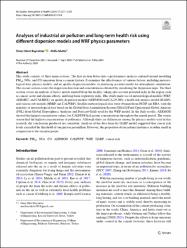| dc.contributor.author | Bayraktar, Ömer Mert | |
| dc.contributor.author | Mutlu, Atilla | |
| dc.date.accessioned | 2025-01-22T10:44:27Z | |
| dc.date.available | 2025-01-22T10:44:27Z | |
| dc.date.issued | 2024 | en_US |
| dc.identifier.issn | 1873-9318 / 1873-9326 | |
| dc.identifier.uri | https://doi.org/10.1007/s11869-024-01573-8 | |
| dc.identifier.uri | https://hdl.handle.net/20.500.12462/15884 | |
| dc.description | Mutlu, Atilla (Balikesir Author) | en_US |
| dc.description.abstract | This study consists of three main sections. The frst section delves into a performance analysis centered around modeling
PM10, NOx, and CO emissions from a cement factory. It examines the efectiveness of various factors, including meteorological data, physics models, and air quality dispersion models, in producing accurate results for atmospheric simulations.
The second section covers the dispersion direction and concentrations obtained by visualizing the dispersion maps. The third
section covers an analysis of heavy metals emitted from the facility, taking into account potential risks in the region such
as cancer, acute and chronic efects, and long-term respiratory risks. This study made use of meteorological models (WRF,
AERMET, and CALMET), air quality dispersion models (AERMOD and CALPUFF), a health risk analysis model (HARP),
and various sub-models (MMIF and CALWRF). Satellite meteorological data were obtained from NCEP and ERA, with the
majority of meteorological data based on the Global Data Assimilation System (GDAS)/Final Operational Global Analysis
(FNL) from Global Tropospheric Analyses and Forecast Grids used for the WRF model. In the daily results, AERMOD
showed the highest concentration values, but CALPUFF had greater concentrations throughout the annual period. The winter
season had the highest concentrations of pollutants. Although there are diferences among the physics models used in this
research, the conclusions produced are consistent. Analysis of the data from the HARP model suggested that cancer risk
levels exceeded the threshold of one person per million. However, the proportion of exceedance instances is rather small in
comparison to the receptor points. | en_US |
| dc.language.iso | eng | en_US |
| dc.publisher | Springer Science and Business Media B.V. | en_US |
| dc.relation.isversionof | 10.1007/s11869-024-01573-8 | en_US |
| dc.rights | info:eu-repo/semantics/openAccess | en_US |
| dc.rights.uri | http://creativecommons.org/licenses/by/3.0/us/ | * |
| dc.subject | PM10 | en_US |
| dc.subject | NOx | en_US |
| dc.subject | CO | en_US |
| dc.subject | AERMOD | en_US |
| dc.subject | CALPUFF | en_US |
| dc.subject | WRF | en_US |
| dc.subject | HARP | en_US |
| dc.subject | Cancer Risk | en_US |
| dc.title | Analyses of industrial air pollution and long-term health risk using different dispersion models and WRF physics parameters | en_US |
| dc.type | article | en_US |
| dc.relation.journal | Air Quality Atmosphere and Health | en_US |
| dc.contributor.department | Mühendislik Fakültesi | en_US |
| dc.contributor.authorID | 0000-0002-0777-0863 | en_US |
| dc.contributor.authorID | 0000-0001-5478-3598 | en_US |
| dc.identifier.volume | 17 | en_US |
| dc.identifier.issue | 10 | en_US |
| dc.identifier.startpage | 2277 | en_US |
| dc.identifier.endpage | 2305 | en_US |
| dc.relation.publicationcategory | Makale - Uluslararası Hakemli Dergi - Kurum Öğretim Elemanı | en_US |




















